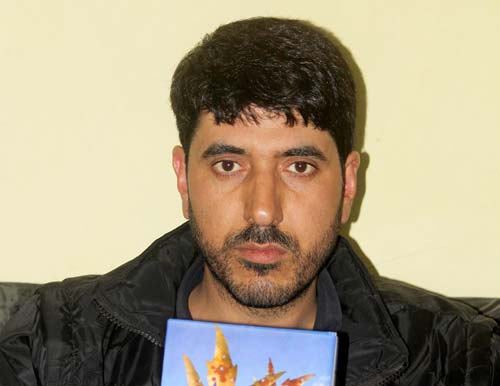At the peak of 2010 unrest in Kashmir valley, Ess Ahmad Peerzada decided to compile a book to tell the story of victims through the eyes of their families. His rise to fame has been torturous and a shimmering example of human resilience and dedication, Junaid Nabi Bazaz reports.

It was in the last week of August 2012 that Ess Ahmad Peerzada completed his book Waad-i-Khoonaab (Valley of Carnage). From a burning state, Kashmir had transformed into a land of peace where tourists come for picnicking. Peerzada wanted to self-publish his book but he found it impossible for the want of money. He then visited many publishing houses in Kashmir. While some of them turned down the draft, others offer to make some changes which he found refused. A publisher had even offered him money in lakhs of rupees but he rejected it.
“I have not written it for money,” says Peerzada. “I have dedicated it to those mothers who lost their sons, wives who lost their husbands and children who became orphans.”
The idea of writing the book came during the summer of 2010 when the valley of Kashmir was seething with rage against a spate of killings by forces. Peerzada was on his way to a friend’s home when he saw a group of youth hurling stones at J&K police. It was this scene, he says, that induced him to write a book.
“I thought I should also contribute to the movement but sloganeering or pelting stones was not my cup of tea. It disturbed me a lot. Later it struck me that I should document the stories of all those who were killed and compile it in a book,” he says.
The book gives accounts of 125 families, starting from the first killing of 2010 when 17-year-old Innayat-u-Allah Khan of Dal Gate, Srinagar, was killed on January 2010 to the killing of 13-year-old Arif Ahmad Bhat of Habba Kadal on December 12, 2010.
Peerzada says he wrote the book using perspective of the victim’s family. “I wanted to tell the story of these families through what the government has to say about these cases,” he says. Initially, Peerzada and one of his friends vowed to work together for the book but he ended up writing it solo.
He says he confronted many problems during the research. The first was to know the whereabouts of the victims. The other was managing time. Having worked as a sub editor with a vernacular weekly magazine, Peerzada had no time in the day to work on his book. He needed to travel across Kashmir valley to meet the victims. “At time, I couldn’t even afford to travel because I had no bus fare. I visited them on weekends which affected my family life,” he says.
Hailing from a small hamlet of Wilgam in north Kashmir’s Kupwara district, Peerzada works in Srinagar and on the weekends, he visits family. “I barely visited home and my relatives. I was totally cut-off during that period,” he says. His extended stays became a problem as his family started asking him why he was not turning up at home on weekends and he was not able to explain.
Peerzada had never thought of writing a book. But that scene of protests during 2010 uprising changed his life forever. His writing skills which he acquired from an editor while working as a manager at a local weekly proved handy. “My initial write-ups were bizarre. They were not worth to be published,” he says. But his editor always encouraged him to write more which helped him to better his work.
While narrating his journey of writing, he vividly recalls an incident when his editor told him to report an event that took Peerzada on surprise. He never knew the language of news. “It took me many days to write. When I submitted the report, I didn’t come to office for fifteen days because I thought what I wrote was rubbish,” he says.
Born and brought up in a poor family, Peerzada completed his education under severe austerity. Up to Class 8, his family could not afford his books and he had to hire them from his seniors. For most of the time, he attended the school barefooted. After passing Higher Secondary Exams, he got a scholarship from the state government for two year computer diploma. He also got Rs 1000 stipend every month. “During that time, I didn’t take even a penny from my family,” he says.
It was in that period, he says, that he got married at the age of 21. While he was unemployed, he was personally bearing expenses of his studies. Now, another burden was put on his shoulders. “It was my father’s will, so I could not turn him down,” says Peerzada. Today, he is father of three children.
















IT IS OF COURSE A STRUGGLE BUT IT SEEMS THE WRITER HAS BEEN PRESENTED IN A BAD LIGHT WHICH HAS NOT JUSTIFIED THE PROFILE.
THERE IS SOMETHING MORE THAT PROMPTED THE AUTHOR TO TAKE THE TASK IN HIS HANDS AND THAT IS MISERABLY MISSING!